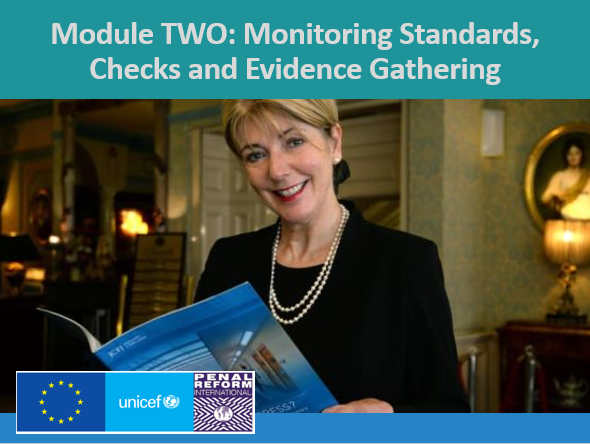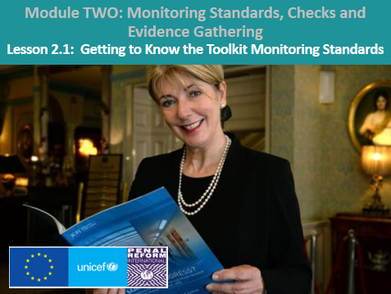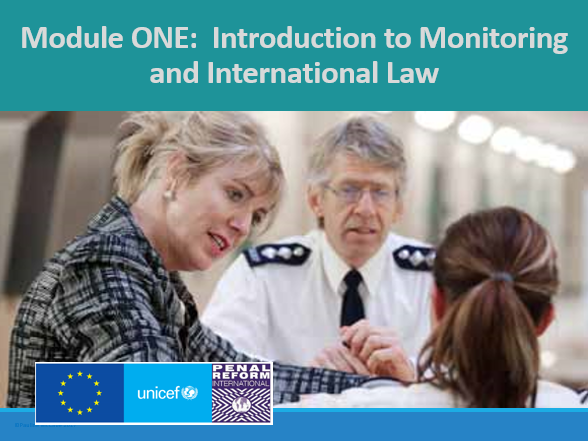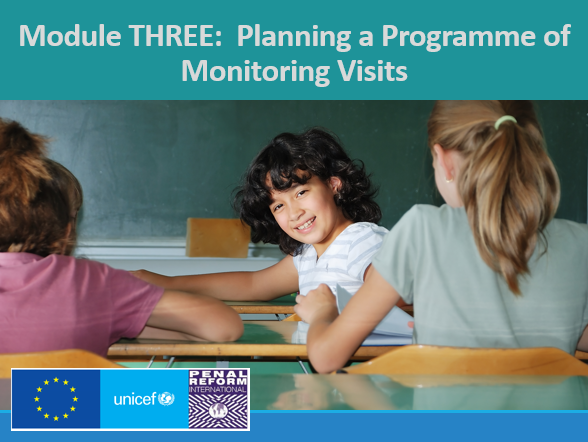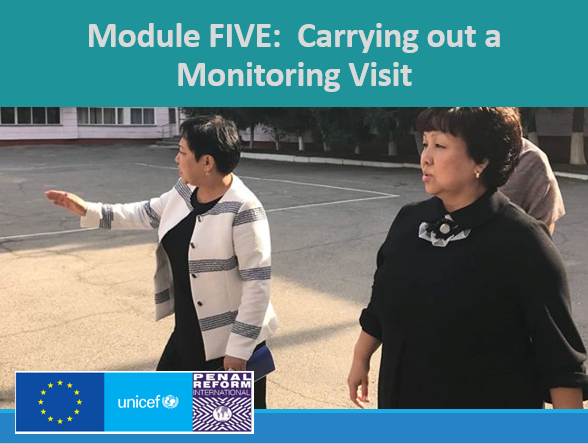Monitoring Places where Children are Deprived of their Liberty
by Professor Pauline McCabe OBE
International Criminal Justice Advisor and former Prisoner Ombudsman for Northern Ireland
International Criminal Justice Advisor and former Prisoner Ombudsman for Northern Ireland
|
Monitoring Toolkit Handbooks and Resources
|
Module TWO - Monitoring Standards, Checks and Evidence Gathering
Introduction
Welcome to Module Two.
The aim of this module is to introduce you to standards and checks that you can use when carrying out a monitoring visit to a place where children are deprived of their liberty. These standards and checks are designed to make sure that the human rights of children deprived of their liberty are properly protected. The standards are based on international fundamental rights of children and are detailed in the Monitoring Toolkit Handbook One.
During the module, you will be asked to study the Monitoring Toolkit Handbook One and to become familiar with monitoring areas, standards and checks relevant to every place where children live in closed or semi-closed conditions. You will also look at gender specific standards, prepared to address the requirement for special attention to the care of girls.
Module Two also looks at the evidence sources that monitors can use to help them assess whether a visited facility is meeting the requirements of the monitoring standards and whether changes or improvements are needed.
The module has three lessons:
2.1 Monitoring Standards and Checks
2.2 Gender Specific Standards
2.3 Gathering Evidence to Assess Performance Against Standards
The Module contains:
· Three PowerPoint presentations
· Two “Task Time” Exercises
· Handbook reading
· An evidence source checklist.
· An assessment
Once you have finished working through the module, mark the checkbox to show completion. The estimated time to complete this module is 2.5 hours.
The aim of this module is to introduce you to standards and checks that you can use when carrying out a monitoring visit to a place where children are deprived of their liberty. These standards and checks are designed to make sure that the human rights of children deprived of their liberty are properly protected. The standards are based on international fundamental rights of children and are detailed in the Monitoring Toolkit Handbook One.
During the module, you will be asked to study the Monitoring Toolkit Handbook One and to become familiar with monitoring areas, standards and checks relevant to every place where children live in closed or semi-closed conditions. You will also look at gender specific standards, prepared to address the requirement for special attention to the care of girls.
Module Two also looks at the evidence sources that monitors can use to help them assess whether a visited facility is meeting the requirements of the monitoring standards and whether changes or improvements are needed.
The module has three lessons:
2.1 Monitoring Standards and Checks
2.2 Gender Specific Standards
2.3 Gathering Evidence to Assess Performance Against Standards
The Module contains:
· Three PowerPoint presentations
· Two “Task Time” Exercises
· Handbook reading
· An evidence source checklist.
· An assessment
Once you have finished working through the module, mark the checkbox to show completion. The estimated time to complete this module is 2.5 hours.
Lesson 2.1: Monitoring Standards and Checks
In this lesson you will consider the standards and checks that will you will use during your monitoring visits to assess the service and care provided to the children who live in the facility.
Please begin by clicking on the Presentation Icon to look at PowerPoint 2.1.
Please begin by clicking on the Presentation Icon to look at PowerPoint 2.1.
Check your Handbook
Now that you have looked at examples of the standards and checks detailed in the Monitoring Toolkit, click the Handbook Icon to download and view Handbook One. You should now read pages 1 to 36, before completing the case study exercise that follows.
The gender specific checks described on Pages 36 to 42 of Handbook One will be discussed in the next lesson.
The gender specific checks described on Pages 36 to 42 of Handbook One will be discussed in the next lesson.
Exercise Time!
Now that you have studied the standards and checks in Handbook One, click on the Exercise Icon below to complete Exercise 2.1. Exercise 2.1 asks you to use the standards and checks to complete a monitoring case study. Remember to save your answer sheet!
Exercise Time! Suggested Answers
Thank you for completing Exercise 2A. Now click on the Exercise Time Answer Icon below and look at the suggested answers. In practice, evidence examined may be relevant to a wide range of standards and checks. You may have included other answers, which is great.
Lesson 2.2: Gender Specific Standards
Girls and young women deprived of their liberty have gender-specific characteristics and needs and are especially vulnerable. Gender specific needs span a wide range of aspects of the regime provided for detained girls and include health and mental health care, rehabilitation programmes, the training of staff and visiting rights.
In this lesson, you will consider some of the challenges faced by girls deprived of their liberty and examine the gender specific standards detailed in the Monitoring Toolkit Handbook One.
Please begin by clicking on the Presentation Icon to look at PowerPoint 2.2.
Check Your Handbook
Now that you have looked at examples of the gender specific standards and checks detailed in the Monitoring Toolkit, click the Handbook Icon to download and view Handbook One. You should now study the gender specific checks described on Pages 36 to 42.
Full account should be taken of these standards when planning monitoring visits to places where girls are deprived of their liberty.
Full account should be taken of these standards when planning monitoring visits to places where girls are deprived of their liberty.
Lesson 2.3: Gathering Evidence to Assess Performance against Standards
The comprehensiveness of the evidence the monitoring group accesses and examines is key to the integrity and rigor of the independent assessment of the performance against the monitoring standards, of the visited facility. Monitors should use a wide range of evidence sources.
In this lesson, you will consider what kind of evidence you should collect and examine when carrying out monitoring checks.
Please begin by clicking on the Presentation Icon to look at PowerPoint Presentation 2.3.
In this lesson, you will consider what kind of evidence you should collect and examine when carrying out monitoring checks.
Please begin by clicking on the Presentation Icon to look at PowerPoint Presentation 2.3.
Now that you have studied the standards and checks in Handbook One and considered the requirements of effective evidence gathering, click on the Task Time Icon below to complete exercise 2.3. Exercise 2.3 asks you to think about the evidence sources that you will use as a monitor.
Exercise Time! Suggested Answers
Thank you for completing Exercise 2.3.
Now compare your answers with Checklist 2Ch. Checklist 2Ch describes some of the evidence sources that may be available to a monitoring group. Not all of the sources listed will be available at or relevant to every facility. Some of the evidence sources suggested may be most relevant where specific concerns are brought to the attention of a monitoring group.
You may have thought of other examples, based on your own knowledge and experience!
Now compare your answers with Checklist 2Ch. Checklist 2Ch describes some of the evidence sources that may be available to a monitoring group. Not all of the sources listed will be available at or relevant to every facility. Some of the evidence sources suggested may be most relevant where specific concerns are brought to the attention of a monitoring group.
You may have thought of other examples, based on your own knowledge and experience!
Module Two Assessment
You have now completed Module Two and it is time for your Module Assessment. Please click on the Assessment icon and answer the questions. When you have completed the Assessment, you will be given your score.
Good luck!
Good luck!

